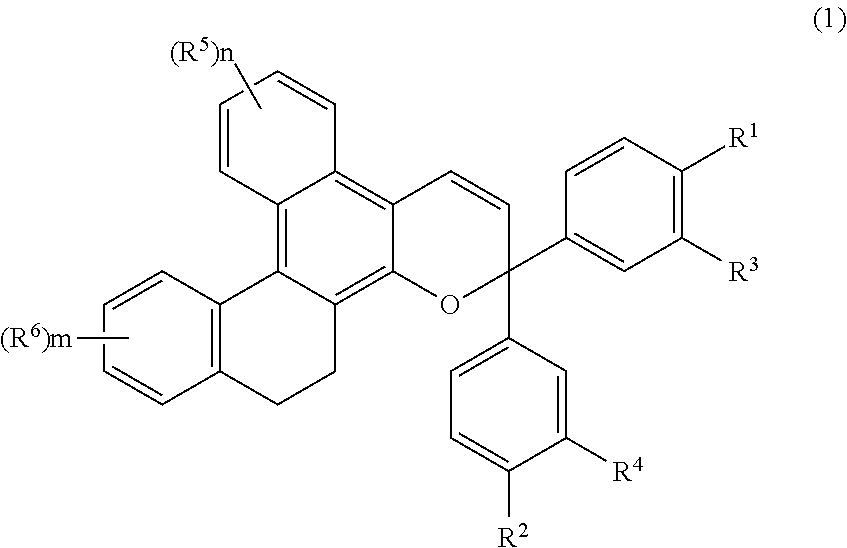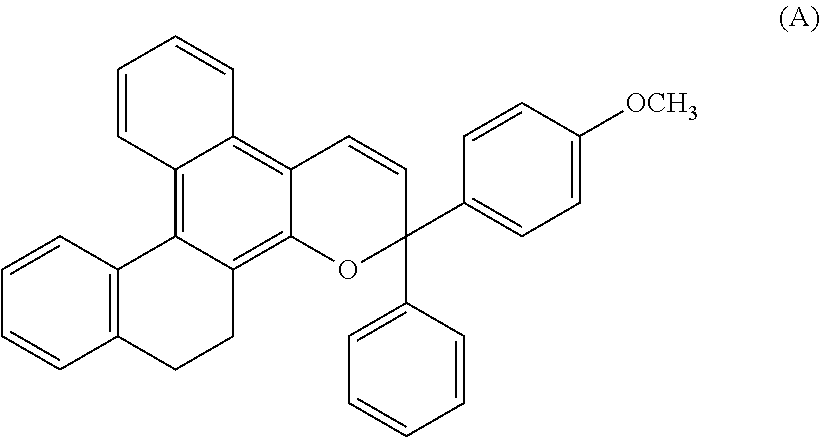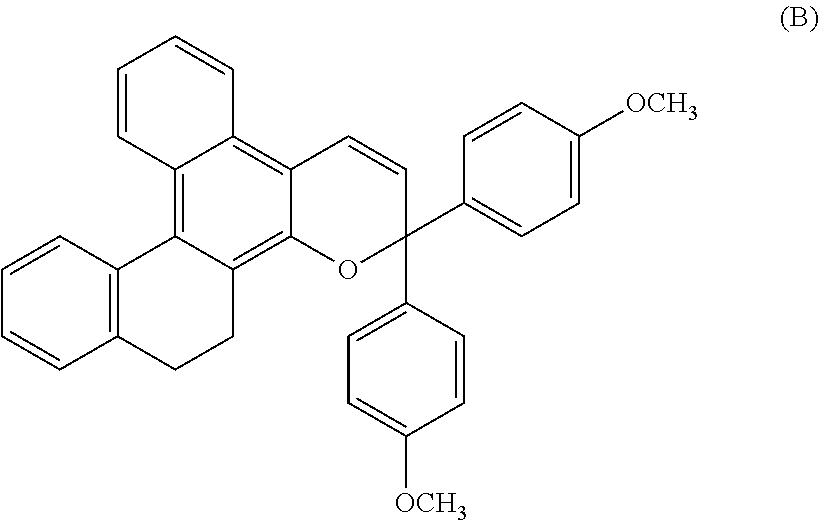Chromene compound
a compound and compound technology, applied in the field ofchromene compound, can solve the problems of low color optical density and high fading speed, and achieve the effects of preventing yellowing of curable compositions, excellent photochromic properties, and weak initial coloration
- Summary
- Abstract
- Description
- Claims
- Application Information
AI Technical Summary
Benefits of technology
Problems solved by technology
Method used
Image
Examples
example 1
[0175]4.9 g (20 mmol) of the following naphthol derivative and 5.2 g (22 mmol) of the following propargyl alcohol derivative were dissolved in 300 ml of toluene, and 0.05 g of p-toluenesulfonic acid was further added to the resulting solution and stirred at a reflux temperature for 30 minutes. After a reaction, the solvent was removed, and the resulting solution was purified on silica gel by chromatography to obtain 3.5 g of a white powder product.
[0176]As for the elemental analysis values of this product, 90.30% of C, 6.06% of H and 3.64% of O were contained and perfectly matched 90.52% of C, 6.00% of H and 3.48% of O as calculation values of C35H28O.
[0177]When the proton nuclear magnetic resonance spectrum of the product was measured, a 10H peak based on an alkylene group was seen at δ of around 0.5 to 4.0 ppm and 18H peak based on an aromatic proton and the proton of an alkene were seen at δ of around 5.0 to 9.0 ppm.
[0178]Further, when the 13C-nuclear magnetic resonance spectrum ...
examples 2 to 16
[0180]Chromene compounds shown in Tables 1, 2, 3 and 4 were synthesized in the same manner as in Example 1. When the obtained products were analyzed by using the same structure identification means as in Example 1, it was confirmed that they were compounds represented by structural formulas shown in Tables 1, 2, 3 and 4. The results of structural analysis are shown in Table 5.
TABLE 1Raw materialsEx.NaphtholPropargyl alcoholYieldNo.derivativederivativeProduct(%)236324421539Ex .: Example
TABLE 2Raw materialsEx.NaphtholPropargyl alcoholYieldNo.derivativederivativeProduct(%)637717819929Ex .: Example
TABLE 3Raw materialsEx.NaphtholPropargyl alcoholYieldNo.derivativederivativeProduct(%)1033112612291331Ex .: Example
TABLE 4Raw materialsEx.NaphtholPropargyl alcoholYieldNo.derivativederivativeProduct(%)143515281625Ex .: Example
TABLE 5Elemental analysis value (%)Ex.Experimental valueCalculated value1H-NMRNo.CHOCHO(NMR)287.415.996.6087.475.876.66δ5.0-9.0 18Hδ0.5-4.0 10H390.326.273.4190.346.323.34...
example 17
Evaluation of Physical Properties of Photochromic Cured Product Formed by Coating
[0181]The chromene compound obtained in Example 1 was mixed with a photopolymerization initiator and polymerizable monomers, and the resulting mixture was applied to the surface of a lens substrate and exposed to ultraviolet light to observe the polymerization state of the coating film on the surface of the lens substrate. A photochromic curable composition comprising 2,2-bis(4-methacryloyloxypentaethoxyphenyl)propane, polyethylene glycol diacrylate (average molecular weight of 532), trimethylolpropane trimethacrylate, polyester oligomer hexaacrylate (EB-1830 of Daicel UCB Co., Ltd.) and glycidyl methacrylate as polymerizable monomers in a weight ratio of 50 / 10 / 10 / 10 / 10 part by mass was used. After 1 part by mass of the chromene compound obtained in Example 1 was added to and fully mixed with 90 parts by mass of a mixture of these radically polymerizable monomers, 0.3 part by mass of CGI1800 {a mixture ...
PUM
| Property | Measurement | Unit |
|---|---|---|
| δ | aaaaa | aaaaa |
| δ | aaaaa | aaaaa |
| δ | aaaaa | aaaaa |
Abstract
Description
Claims
Application Information
 Login to View More
Login to View More - R&D
- Intellectual Property
- Life Sciences
- Materials
- Tech Scout
- Unparalleled Data Quality
- Higher Quality Content
- 60% Fewer Hallucinations
Browse by: Latest US Patents, China's latest patents, Technical Efficacy Thesaurus, Application Domain, Technology Topic, Popular Technical Reports.
© 2025 PatSnap. All rights reserved.Legal|Privacy policy|Modern Slavery Act Transparency Statement|Sitemap|About US| Contact US: help@patsnap.com



